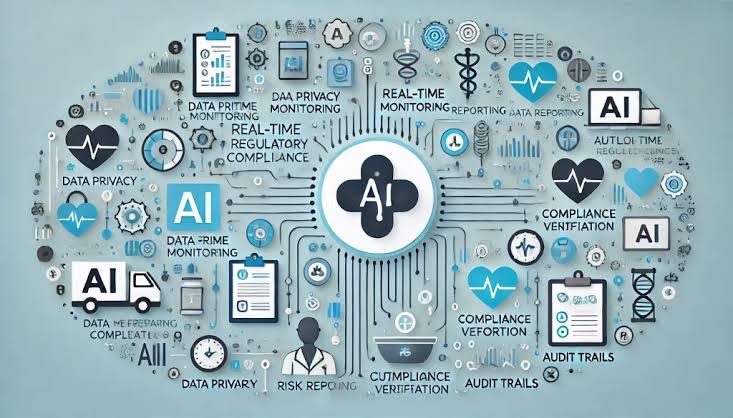Explore how AI-powered compliance automation enhances regulatory adherence by increasing efficiency, accuracy, and risk management. Learn about the benefits of AI tools, implementation best practices, and strategies for overcoming challenges to streamline your compliance processes effectively.
Automation of Compliance Using AI Technology Ensuring Compliance With Regulations.
Introduction
In the fast moving world of business ensuring compliance with regulations is essential for companies in industries. Traditional methods of compliance can be slow prone to mistakes and expensive. As rules become more complex businesses are turning to intelligence (AI) to simplify their compliance processes. AI driven automation offers a game changing way to guarantee adherence to regulations improving efficiency, accuracy and effectiveness. This article delves into how AI contributes to compliance automation its advantages and best practices for implementing it.
Understanding AI Driven Compliance Automation
AI driven compliance automation leverages technologies like learning, natural language processing (NLP) and data analysis to oversee and ensure compliance with regulations. By automating tasks, processing data and delivering insights AI tools assist organizations in staying compliant while minimizing effort and reducing errors.
Machine learning algorithms have the ability to detect patterns and anomalies in data that could signal compliance issues. Natural language processing can understand and analyze documents ensuring that organizations stay informed about changing regulations. Data analytics tools gather and examine data related to compliance to produce reports and insights that support decision making.
Advantages of Using AI for Compliance Automation.
1. Improved Efficiency. AI powered tools streamline time consuming compliance tasks like tracking regulatory updates, organizing paperwork and conducting audits. By automating these processes compliance teams can shift their focus towards activities leading to enhanced effectiveness and productivity.
2. Increased Precision. AI systems reduce the risk of errors by performing tasks with accuracy and consistency. Automated data input and verification procedures help minimize mistakes in compliance reports and documentation ensuring adherence to regulations.
3. Real Time Oversight AI technologies offer monitoring, on compliance activities enabling organizations to promptly identify and address issues. Ongoing supervision guarantees that any deviations from regulations are detected and corrected swiftly minimizing the risk of non compliance.
4. Cost Efficiency Streamlining compliance processes through automation reduces reliance on effort and associated expenses. AI technologies can manage volumes of data and intricate tasks more effectively than human teams resulting in significant cost savings, in compliance oversight.
5. Enhanced Risk Management AI has the capability to examine data to pinpoint potential risks and weaknesses in compliance procedures. This approach empowers organizations to implement measures and mitigate risks, before they escalate into compliance violations.
6. Adaptability As organizations expand and regulatory frameworks become more intricate AI driven compliance automation can scale up to meet increasing demands. Automated systems can manage data volumes and more complex compliance tasks without compromising accuracy or efficiency.
Implementing AI Driven Compliance Automation.
1. Evaluate Organizational Requirements: Prior, to introducing compliance automation powered by AI it's important to evaluate the specific needs and compliance hurdles of your organization. Pinpoint areas where automation can offer benefits such as monitoring regulations, managing data or streamlining audit procedures.
2. Select Suitable AI Solutions: Choosing the AI solutions is essential for a successful implementation. Take into account aspects like the tools capabilities, compatibility with existing systems and vendor support. Explore alternatives and opt for solutions that align with your organizations compliance objectives.
3. Ensure Data Quality: The success of AI driven compliance automation hinges on data quality. Make certain that your data is precise, comprehensive and current. Establish data management practices to uphold data integrity and improve the performance of the AI system.
4. Integrate With Systems: Blend AI technologies into your organizations existing frameworks and workflows for smooth operations. Ensure that AI tools can communicate seamlessly with other systems like Enterprise Resource Planning (ERP) software or Customer Relationship Management (CRM) platforms to create a cohesive approach, to compliance management.
5. Train And Support Employees: Implementing AI tools successfully involves training and supporting your compliance team. Offer training on how to use the AI tools effectively and address any concerns or challenges they may face. Providing assistance and updates is crucial to ensure that the tools continue to align with your organizations requirements.
6. Monitor And Assess Performance: Regularly track the performance of your AI powered compliance automation tools to ensure they meet your expectations. Assess how automation is enhancing compliance processes minimizing errors and achieving cost savings. Make necessary adjustments to optimize tool performance and resolve any issues that arise.
Addressing Challenges and Considerations
While the use of AI for automating compliance processes brings advantages there are challenges and factors that need to be considered. These include:
1. Safeguarding Privacy and Security Ensuring the handling of sensitive compliance information necessitates robust security measures to prevent breaches and unauthorized access. Its crucial to establish strong privacy and security protocols to protect your organizations data.
2. Adapting to Changes Regulatory standards are subject to change and AI tools must be updated accordingly. Its important to ensure that AI systems are flexible enough to incorporate new regulations as they emerge.
3. Addressing Considerations Integrating AI into compliance management raises ethical dilemmas, regarding transparency and accountability in decision making. Its essential to establish guidelines and practices within your AI approach.
4. Upfront Costs The initial expenditure for implementing AI driven compliance automation tools can be substantial. Its important to assess the potential return on investment (ROI) and weigh the long term advantages against the costs.
Conclusion
The use of AI in automating compliance processes marks progress, in ensuring compliance with regulations. By improving efficiency, precision and risk mitigation AI technology provides assistance in dealing with regulatory frameworks. However successfully integrating AI solutions necessitates planning, seamless integration and continuous support to fully leverage their advantages. Adopting AI for compliance management allows businesses to enhance operational effectiveness. Uphold a dedication, to regulatory compliance.
